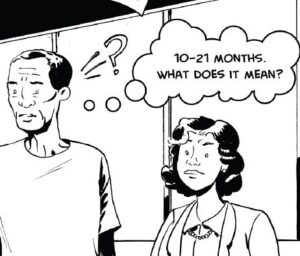
I wrote a comic book about prison. Let me explain why.
 The School of Government recently published its first graphic novel, In Prison: Serving a Felony Sentence in North Carolina. It’s available for purchase here. I wrote it along with Shane Tharrington, classification manager for North Carolina’s Division of Adult Correction. Jason Whitley, a talented artist and designer who works at UNC’s School of Pharmacy, illustrated it.
The School of Government recently published its first graphic novel, In Prison: Serving a Felony Sentence in North Carolina. It’s available for purchase here. I wrote it along with Shane Tharrington, classification manager for North Carolina’s Division of Adult Correction. Jason Whitley, a talented artist and designer who works at UNC’s School of Pharmacy, illustrated it.
The book follows an inmate from the moment his felony sentence is pronounced to the day he completes post-release supervision. It shows where he will go (all inmates process through one of a half-dozen diagnostic centers before moving on to other destinations) and what he might do in terms of work or programs when he gets there. It explains how his stated sentence (10–21 months is the example I used) would typically translate into a real release date (just under 11 months, give or take).
Why a comic book? I get a lot of mail and phone calls from victims, inmates, and their families. It is clear to me from their questions that they don’t always have a clear sense of how a defendant’s sentence will play out in practice. Many people seem to be advised that inmates are always released at their minimum (many aren’t), and few—including inmates who pled guilty and asked for an active sentence—appear to be aware of the mandatory post-release supervision that will follow their incarceration (a “surprise” I wrote about here).
 After over 20 years of Structured Sentencing, phrases like “6–17 months” roll off our collective tongues, and we mentally process the minimum and maximum together as a sort of gestalt: standard low-level felony. But you can imagine a defendant or victim looking at that span of months—each of which constitutes 30 days of liberty deprived or peace of mind, depending on your point of view—and thinking, “Which is it? 6 or 17? Because one of those numbers is, like, three times as big as the other.” This book is meant to offer an accessible explanation of what each number means, and what is most likely going to happen in reality.
After over 20 years of Structured Sentencing, phrases like “6–17 months” roll off our collective tongues, and we mentally process the minimum and maximum together as a sort of gestalt: standard low-level felony. But you can imagine a defendant or victim looking at that span of months—each of which constitutes 30 days of liberty deprived or peace of mind, depending on your point of view—and thinking, “Which is it? 6 or 17? Because one of those numbers is, like, three times as big as the other.” This book is meant to offer an accessible explanation of what each number means, and what is most likely going to happen in reality.
Of course it’s not lost on me that a comic book is not right for every situation. A legal assistant in a prosecutor’s office talking to the victim of a serious sex crime or a lawyer advising a client charged with one might hesitate to slide a cartoon across the table to explain what might happen.  But in certain situations—with young people in particular, perhaps—you may find it useful. It’s just another way of presenting the same legal information I have covered elsewhere, like on this blog, and in the short explanatory videos on my YouTube channel. I hope it doesn’t come across as tone deaf or ivory tower, because I try not to be that way.
But in certain situations—with young people in particular, perhaps—you may find it useful. It’s just another way of presenting the same legal information I have covered elsewhere, like on this blog, and in the short explanatory videos on my YouTube channel. I hope it doesn’t come across as tone deaf or ivory tower, because I try not to be that way.
In addition to Shane and Jason, I want to thank Kevin Justice of the School’s publications team for getting the book to press. It was printed by inmates at Nash Correctional Institution through Correction Enterprises. As you’d learn from the book, an inmate job like that would generally yield 9 days of earned time per month.
